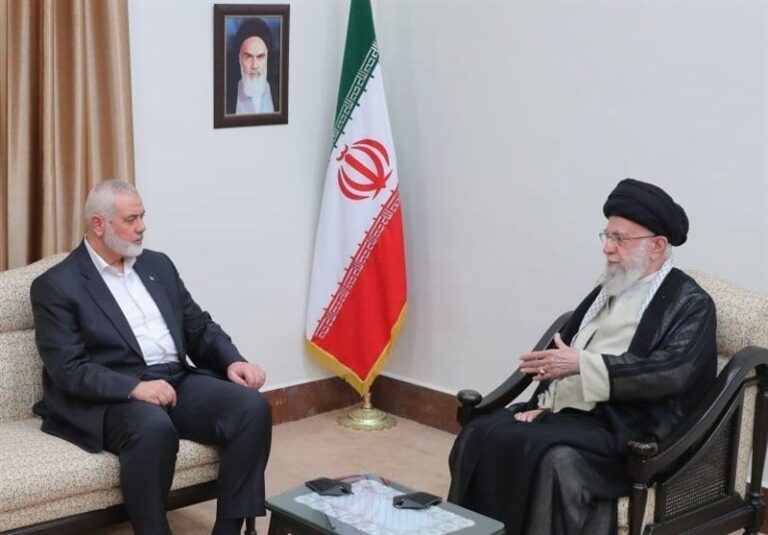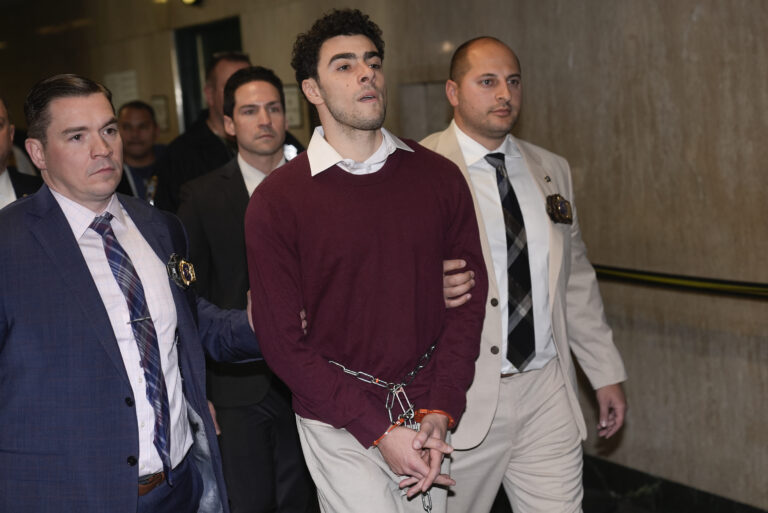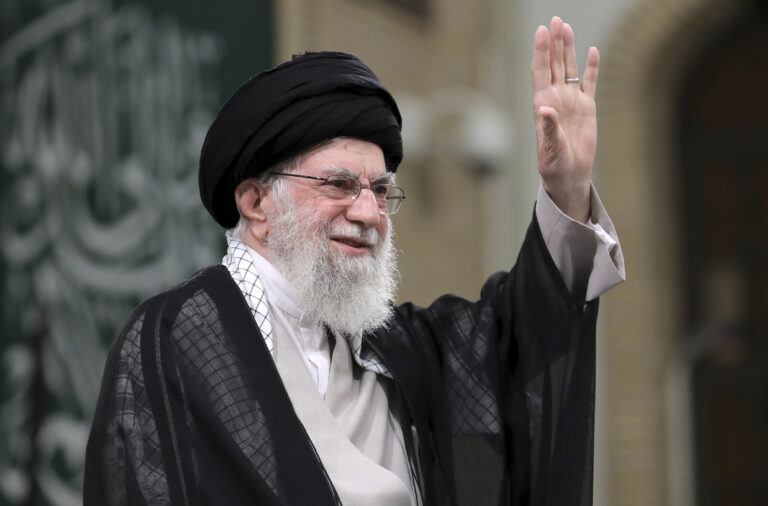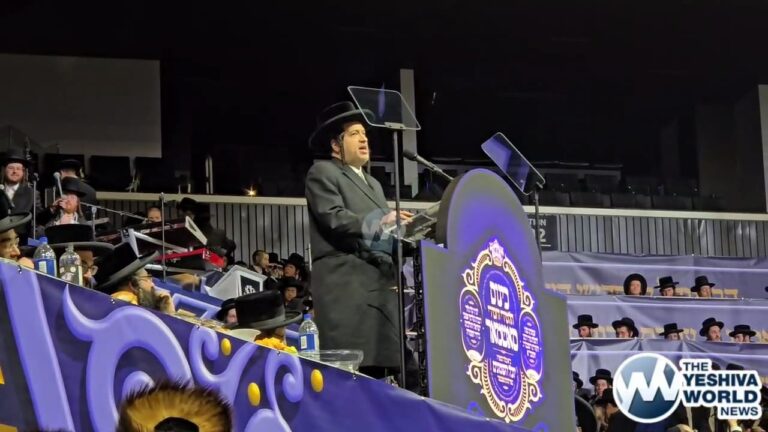 Written by Rabbi Menachem Krybus, a father of one of the imprisoned מקדשי השם
Written by Rabbi Menachem Krybus, a father of one of the imprisoned מקדשי השם
There is a fascinating medrash Chazal about the way Queen Esther went about trying to annul the decree of the wicked Haman. After meticulously planning one feast after another with Achashverosh and Haman, she finally reached the deciding moment with her famous accusation “Ish tzar ve’oyev Haman ha’ra ha’zeh“ (‘An adversary and an enemy, this wicked Haman’). Chazal tell us that when she said that, she actually pointed to Achashverosh and an angel had to come down and push her hand towards Haman. This seems hard to fathom. What was she thinking to accomplish by antagonizing the king himself?
The answer is that Chazal tell us that every time it says “Hamelech” – “the king” in the Megilla it is referring to Hashem. Now, Queen Esther also knew this. She knew that really behind the scenes it was Hashem alone Who was in charge. So, while she did her Hishtadlus and spoke to the flesh-and-blood king, she all the while saw herself standing in front of the King of Kings and beseeching Him. It was to Him that she was really speaking. That is how it happened that when she reached the climax, the deciding moment, then in the intensity of her beseeching Hashem, she totally forgot she was supposed to be talking to Achashverosh too.
That is the feeling we all had when shlomei emunei yisroel came out in their throngs to escort our brothers the prisoners, mekadshei Hashem, to their sentence. Although it was also meant to show the Israeli government that no force in the world would cause us not to listen to our Gedolim, yet at the time of the rally we were totally caught up in our Shir HaShirim to Hashem. Thousands upon thousands of amcha beis yisroel were busy proclaiming their love and complete devotion to Hashem and Gedolei Yisroel and their leaders. As one of the would-be prisoners put it, “You are threatening us with prison? That’s small change. We are ready to give up so much more for Hashem and for hisTorah, for the pure chinuch of our children, for our faithfulness to Gedolei Yisroel. In the spiritual uplifting of the ma’amad we forgot all about the state, its government and its woes. That is how we were able to achieve a near miracle of having three hundred thousand animated Yidden gathered together for hours without any incidents. When you love someone very much you are thrilled when an opportunity comes up to show him your devotion. The prisoners were going with song and joy to serve their prison sentences for the explicit “sin” of listening to the p’sak of the Gedolim. Every fiber of their being exuded their exhilaration at being given the opportunity to show their love for Hashem. After leaving the masses behind them they entered the prison gates singing “Pischu li sha’arei tzedek avo vam odeh K-ah” – ‘open up the gates of righteousness, I will pass through them and praise Hashem’ – and when the last dignitaries left and they handed themselves over to the police they joined hands and started singing -“Veyihyu rachameicha misgolelim al am kodshecha” – ‘and may your pity be cast upon your holy nation’ – with the holy niggun of Reb Aharon of Karlin TZ”L. Hardened policemen shed tears witnessing this. Had ever a prisoner in history entered prison in such a manner? As the Slonimer Rebbe shlit“a put it, “hikuni p’tza’uni, nas’u es redidi me’alai… im timtze’u es dodi mah tagidu lo” (Shir Hashirim) (‘They smote me, they wounded me; The keepers of the walls took away my mantle from me’). And like Esther in her time, the Slonimer Rebbe shlit”a had pointed out in his ‘shmiess’ (speech) in Emanuel, that they were not waiting for rachmanus from the government, only from Hashem the ba’al harachamim Himself. When Rav Shteinman shlit”a visited the prisoners, he quoted the Chofetz Chaim tz”l who said that the clever thing to do is always to be on the side of the winners, and the ultimate winner is always Hashem. Baruch Hashem that with the agreement that was just reached and the release of our dear brothers, the asirim mekadshei Hashem, we were zoche to see that victory. “Zeh hayom asa Hashem nagila venismecha bo!” (‘this is the day which Hashem has made, we will rejoice and be glad in it’). Sadly, however, while Esther was confronting an “ish tzar ve’oyev“, an enemy, we had to confront our own brothers, our flesh and blood, who, as tinokos shenishbu by the Zionist educational system, had reached this low point where a judge who calls himself religious challenged the supremacy of the Torah. The day after the rally, at the conclusion of tefillas shacharis, the Slonimer Rebbe shlit”a asked to say a perek of Tehillim, and added the passuk “yitamu chata’im min ha’aretz” – ‘may sins be abolished from this earth’ – noting the explanation of chaza”l that it says “chata’im” (sins), and not “chot’im” (sinners). We do not pray that the sinners should be punished. Instead, we pray that the sinners should merit to repent. Then there will no more sins to worry about. When that day will finally come, we will all join hands, and standing shoulder to shoulder, proclaim together “ki la’Hashem hamelucha” – ‘to Hashem belongs the rulership”. Then our joy will finally be complete.
Throughout this saga, I found it very disconcerting to see that many well meaning Jews in America were ignorant of the real facts. It was bewildering to see that while people were brewing up a false libel against us, the Charedi media did not come out strongly enough to set the record straight and bring the true facts to light (see box). There should have been a stronger and more forceful denial. The story of the Chassidic school in Emanuel, is one of parents tossing sleeplessly in bed at night worrying about their precious little Chanale or Malkale who were coming home with newly acquired coarse language, with new ideas about how to dress, with access to a foreign world from which they had worked so hard to shelter them. It was the story of parents whose only wish was to see their children grow up pure and refined, as befitting future wives of Torah scholars, who will build homes full of kedusha. It was the story of ashkenazi Chassidim together with Sephardic Bnei Torah who took off from their meager salaries and, hand in hand, worked hard to create a school for their children. It had nothing to do with whether one was a Sephardi or Ashkenazi (see box). It had to do with meeting the different chinuch needs and standards of two different levels of Torah commitment. Anyone who was willing to keep the stricter modest dress code was accepted (see box). For a nation that had received a mission of “ve’atem tihyu li mamleches kohanim vegoy kadosh“ (‘and you shall be for Me a kingdom of priests and a holy nation’), was that a sin? It might be forgivable that the secular Jew, who was shielded by the secular media from receiving the real facts, to whom the whole concept of protecting children from the street’s influence was, in any case, so foreign, was willing to buy this libel. But for a heimishe Yid who knows the ways of Chassidim and Sephardic Bnei Torah, just one look at the common denominator of the group should have told him the true story. Many people owe an apology to these chasuve avreichim who showed their utmost mesirus nefesh, and while being mekadesh shem shamayim, as Gedolim from the full spectrum of Charedi world testified, were zoche today to bring about a great victory to Charedi Judaism in the war constantly waged against it by the secular establishment.
How do we know that there was no ethnic discrimination in the Chassidic school in Emanuel?
Some points to consider
1. More than 30% of the girls in the school are Sephardi (25 out of 80).
2. Every girl – regardless of her ethnic background- who agreed to sign the school regulations was accepted into the school.
No one was ever denied because of ethnic reasons or other. This was not challenged by the petitioners and was acknowledged by the special investigator sent by the Ministry of Education in his official report, who wondered-“im seruv ayin – aflaya minayim“- “if there was no denying entrance – where was the discrimination?”
3. 17 out of the 43 fathers who went to jail were Sefardi-
They carried signs stating “I am a Sephardic father going to jail for wanting to give my daughter a Chassidic education”. They also spoke at the rallies in Jerusalem and Bnei Brak on their way to prison, passionately refuting that the school split had anything to do with being Ashkenazi or Sephardi. They reiterated that it was solely a matter of religious standards.
4. Six out of the eight mothers going to prison were Sefardi –
Were they showing all this מסירות נפש just so that they could discriminate against their Sefardi sisters?
5. After the petition was entered, the Ministry of Education sent a non-religious investigator, Dr Mordechay Bess (former CEO of the state comptroller’s office) who concluded that without any doubt there was no discrimination, as the issue was not ethnic but religious- in his words- “not adati (ethnic) but dati (religious)”. He also noted that after sitting with both parties and noting the differences, he could see why the Chassidim felt they needed a different school.
6. 80% of the parents in the general school signed a petition to court stating that they were very satisfied with the two-track arrangement and did not want it changed.
7. While the assumption that it was meant only for Ashkenazim left you with a discrepancy of 30% Sephardim in the school, the assumption that it was meant for any ben Torah who wanted to live according the strict standards of Chassidim and bnei Torah, left you with a 100% consistency, since all parents in the Chassidic track were of that group.
8. It is well known how much Chassidim and bnei Torah take the issues of being influenced from the media etc. to heart. It makes no difference to them whether the television or internet etc. emanates from a Sefardi home or an Ashkenazi one. The same goes for modest dress and language.
9. It was not their fault that it so happened that in this specific town, more Ashkenezim than Sephardim were of the bnei Torah type and were interested in their lifestyle.
10. There was a separate religious school for Sephardim only in town (El Hamayan) comprised of parents who had left the general school when Shas established El Hamayan, yet the court did not allow the Chassidim to leave and open their own school (even though it had Sephardim also).
As a religious Jew you surely know of many such schools that were opened by Chassidim that were opened solely to protect them from street influence and uphold chinuch standards.
And yet, the Israeli High court of Justice chose to ignore the facts, ignore the evidence, ignore the conclusions which the Ministry of Education reached when investigating the matter thoroughly – and declared the school guilty
Now you have the basic facts, You be the judge.
Now, as I sat and listened to one of our Charedi news outlets misquote to half of unsuspecting American Jewry the agreement reached, as if the avreichim had signed to comply with court orders, I was again baffled by the phenomena. Why were we working against ourselves and making our victory sound like a capitulation? It’s enough that the secular media will do their best to try to twist it that way. So I decided to present the true details together with the motives behind each detail. Going out from this struggle with a strong sense of victory – as it truly was – will do wonders to strengthen our resolve and will serve to deter our enemies.
First a little background on what the issues were;
A) The right to educate our children according to our hashkafa and needs.
The court had tried to force upon the parents to send their children to a school which would be a compromise on their chinuch standards. When the court ruled that although they were allowed to have their own school, as was done all over the country, they could not have a separate track in the same school (which had been done with the permission of the Chinuch Atzma’i), they took their children out and made their own school. The Judge who, it seems, had thought that that would be beyond their means, promptly issued a decree to close the school. When asked by the lawyer about his allowance in the first ruling he answered “I changed my mind”. It was as simple as that. What had been legal a minute before became illegal a minute later. They would have to settle for a less suitable standard of chinuch. What was allowed for others all over the country would be denied to them. He made it clear that he was bent on having all children learn together and they would never have their own institution. Therefore, they asked the Slonimer Rebbe shlit”a what to do, and were told that chinuch is not an area in which they could compromise, but so as not to anger the court they should commute their children to the Belze school in Bnei Brak. After the first day there, the Belze school received an ultimatum from the Ministry of Education, stating that if they accepted the children for even one more day, they would lose all government funding. Since the Slonimer Rebbe shlit”a, as well as the other poskim, ruled that this was an issue in which they could not capitulate, they kept the children at home and taught them in all kinds of secret places, just like back in Russia in the days of the Czar. The Judge then gave an order that if they did not send their daughters to learn in the general school he would sentence the fathers and mothers to jail. They chose to go to jail.
B) The right to have our spiritual chinuch needs evaluated and decided by the Gedolei Yisroel – not by a secular court.
Instead of having Rabbanim decide on the religious issues, the court took the authority to decide which level of religious chinuch the Chassidic girls needed and deserved. In the beginning, when the Emanuel chassidim still had their own track, the judge ruled that they could not use the code of dress of the posek hador Rav Vozner shlit”a which they had adopted, since in the Judge’s eyes he was a Rav who had a too stringent an approach in issues of modesty!! Afra lefumia! The honorary judge would be our posek, deciding upon who our Rav should be and how our children should dress. Now he was deciding in which environment they were to study.
C) The Judge made it a point to challenge the parents’ allegiance to Gedolei Yisroel in issues the court disagreed with them, even issues of religion and conscience.
He explicitly stated that he was out to prove that the court was stronger than the Gedolei Yisroel, and threw the parents into jail for listening to the psak of the Gedolim. He demanded that they sign that they would obey court orders against these psaks and send their children to the school in dispute. With this he turned the case into a test to see whether the Torah stands above the secular Law or chas veshalom …
Although his original intention was to force the children to learn together, when he saw that the time was nearing and they were prepared to go to jail he tried to coax them into surrendering and signing their allegiance to court, against the psak of their Rebbe and all the Gedolim, by offering that the children attend the general school until the end of this year and then next year they would have their own school. Without hesitating for a minute they immediately turned down his offer and proclaimed in unision Shma Yisroel and Hashem Hu Ha’Elokim in front of the entire court. It was a gevaldige Kiddush Hashem.
As the two weeks in prison dragged on, the Judge saw to his dismay that the fathers were willingly sitting in prison l’maan Shmo Yisborach. The mothers on their part were also preparing to enter prison as soon as the fathers left, as had been his heartless judgment. So last week he made it known that although the original verdict had been for them to be in prison for two weeks, still as long as they didn’t sign that they would obey court and actually send the children to the controversial school, they were continuing being in contempt of court and might be held in prison indefinitely. Furthermore, they should not dream of getting an approval for a private school as long as they didn’t sign. Then he warned that he would throw the Slonimer Rebbe shlit”a himself into prison for instigating revolt. Actually, the Rebbe had himself offered from the start to be imprisoned instead of his Chassidim but the judge had ignored the request. All this lead everyone to believe that no end was in sight and the group might still spend many more weeks in jail. Indeed, on Friday when a prominent Israeli lawyer came to speak with the Judge, offering a similar plan to the one that was in the end accepted, he literally threw him out in anger, proclaiming that as long as they didn’t sign to comply with court they would not see the light of day chas veshalom. With this he was flexing his muscles to scare them into compliance. But the prisoners themselves did not take this to heart and settled in for a lengthy stay. When they were actually freed they couldn’t believe it.
And now about the agreement;
The agreement in a nutshell was like this. The Slonimer Rebbe shlit”a and HaGaon HaRav Ovadia Yosef shlit”a met together in friendship, and issued a joint letter that in order to quiet down the machlokes in Emanuel, they had both mutually agreed that it was important to strengthen the achdus in the city of Emanuel, therefore they agreed that all the schools in Emanuel should come together for three days of speeches from prominent Rabbanim, in order to bring all the hearts closer. No mention was made by them of the court case. Then the petitioners went ahead and wrote to court that from their standpoint this settled the matter and they agreed that each group, would have their own school, with their own regulations, under the guidance of their own Rabbanim. To everyone’s surprise, the court from its standpoint then agreed to view this agreement as a compliance with court orders and freed the prisoners.
At the tish of the Slonimer Rebbe shlit”a right after their release, the Rebbe shlit”a said; ‘I wrote in my letter (which was read in the Knesset) that even if they would place me in front of a firing squad, I would not concede even ‘kekutzo shel yud’ (even in small measure) and so it was, we did not concede on anything which was important to us.
It is important to see how that was so, because that gives us strength and encouragement not to compromise in the future.
The court had, from the start, all the while kept on constantly repeating one thing. Each prisoner had to explicitly sign that he was going to abide and comply with court orders. Then he had to physically return his child to study as a normal student in the general school. Up until that last court session the judge was adamantly refusing to consider anything less.
So, the first thing to point out is that in actual fact no prisoner ever signed any compliance to court whatsoever. In fact they did not sign anything or even give any verbally commitment to court. This was going against the court’s most basic request. In fact, in middle of all this, as the prisoners stood surrounded with two policemen between every four of them and about another one hundred ready for action, they passed over from one to another in whispers, the message they had just received from the רבי שליט”א that if asked to sign any paperwork whatsoever they should categorically refuse. At one point Mrs. Shmueli, the representative of the Education Department, was adamant about their signing, but the lawyer of the defendants was instructed by the Rebbe shlit”a to refuse. Then Rabbi Eli Yishai, the Minister of the Interior, tried to convince her and ultimately contacted her superiors and had her draw back. All this was in keeping with the point they were stressing that in religious matters their allegiance was only to the Rabbanim and da’as Torah.
The court wanted that it should be mentioned in the agreement that three days of speeches would be viewed by the parents as their complying with court orders. However, the court conceded on that matter as well. From the standpoint of the defendants they were going to have the three days of speeches because the Gedolei Yisroel, the Slonimer Rebbe shlit”a and HaRav Ovadia Yosef shlit”a had so decided. This was all in keeping with the point they were stressing that only the Gedolei Yisroel would decide in all their matters of chinuch, not the court. Actually, the defendants were not involved in any aspect of all these dealings. Every move they made from beginning to end was as instructed by their Rebbe. It was the court that was interpreting all this as their compliance and fulfillment of its wishes.
Regarding the second demand the court had so unwaveringly made up until then, that they register the children back as pupils in the general school, the petitioner first tried to push that at least the three days should be described as coming to study together, the two schools only. To this too the Rebbe shlit”a categorically objected. Again they backed down and agreed to three days of speeches for all the schools in the city (this included Chabad and El Hamayan). The difference in all this was that, had only the two schools attended these speeches, it could have been argued that by doing so the two schools had in actual fact merged and were learning together, as the court had requested. By having other, totally unrelated schools participate it was clear that there was no aspect of merging. It was only different schools attending Shiurim together. Furthermore, the refusal for it to be slated as coming to study together was in keeping with the psak of the Gedolim that they should learn only with girls who kept their regulations. Coming to listen to speeches was a totally different concept, as it is customary that when a prominent speaker comes, different schools join to hear him. There was also an intrinsic da’as Torah motive in the Shiurim, the Gedolei Yisroel shlit”a had agreed upon. So these three days ordered by the Gedolim shlit”a were something totally different than the court’s original request that the Chassidic school close down and become part of the general school. All these concessions were so totally unexpected at the beginning of the session. What helped facilitate all this was that Rav Ovadia Yosef shlit”a, the spiritual leader of Sephardic Jewry and the Slonimer Rebbe shlit”a had met so warmly and spoken of the need for achdus between shivtei yisroel. This undermined the judge’s purported reason for waging a war against Slonim.
Aside from the agreement of the Rabbanim for separate schools, the Judges also implied that for the coming school year the Chassidic school would be able to function as a private school. The commentators pointed out that in this lay an important message to the Minister of Education. During the last few years the government and court have been constantly trying to find in ways to impose their views and compel our religious schools to teach according to their values. This Minister had made it clear from the start that he saw his main goal in the ministry, to see to it that the Charedi schools adopt the infamous Liba program, which was a meddling of the secular Education Department in our school curriculum. His original plan had been to use the High Court’s services to enforce such studies in the private religious schools. Indeed, lately there had been a noted eagerness of the court to tackle Charedi issues and bring them under its control,. Now, with the court’s allowing that the private school in Emanuel would be able to run according to the wishes of the parents and the rulings of their Gedolim, it was essentially sending a message to the Minister of education that it would not put any more legal hurdles in front of the private Charedi schools. It seems that the High Court has learned its lesson and does not relish to enter into any new conflicts with Charedi Judaism. In a time when there were many evil decrees looming in the horizon from the direction of the secular government, the incredible achdus and allegiance that our community of hundreds of thousands ken yirbu showed by the demonstration and throughout the imprisonment made a tremendous impression on the secular world and court. Even more so did the heroic stance of the group of ‘chashmonaim’, the parents who went to prison with song and dance, and with tremendous refinement and had now calmly prepared themselves to continue staying in prison for weeks, even months, on end. As soon as my son left the prison he called me to inform me he was out. Being in prison is not a simple ordeal and he was very excited. Actually he couldn’t believe it, since all signs had shown that they had a long indefinite future ahead of them. Yet, I also noted in his voice a tone of disappointment that the special mitzvah of mesirus nefesh that they had been fortunate to fulfill was leaving them. However, when I questioned him about it he simply yet eloquently rounded it all up for me: “We entered into prison to comply with Hashem’s command “ve’asisa kechol asher yorucha” – ‘and you shall not deviate from the word which they will instruct you’ – and now we are going out to comply with that same ” ve’asisa kechol asher yorucha”, as it says “al pi Hashem yachanu, ve’al pi Hashem yis’u” – ‘at the bidding of Hashem they traveled, and at the bidding of Hashem they encamped’.
(Rabbi Menachem Krybus – YWN)











5 Responses
I think we American Jews all understand that you have the right and should definitely have separate school, the court is totally wrong. But even after your lengthy letter there are still some questions left unanswered:
1)EXACTLY what chumrahs where not upheld by those girls that required such extreme separation like putting up mechitzas and warning the girls not to interact. We here in America live between one another, chassidim, litvaks, modern and sephardi our kids know that each child has their own derech, we dont feel need to seperate them physically.
2)Why was the idea of – setting up a beis din of rabbonim to decide if a family is living according to the standards of the school – rejected by the chassidim long before the issue was brought to court?
how true it is so much easer to fulfill the ratzon hashem when conditions are trying yet your duty is clear than when alls easy yet your duty is not as clear
That is THE BEST written, informative and inspiring story I have EVER read on YWN!! I hope you send this article to the secular news outlets as well. Makes me proud!!
Left unanswered as well. How do they expect to have any hashpaa on those not yet frum if they stay away from them like the plague? Granted high school girls are not kiruv experts, but if non frum girls get to see how frum girls act, they just might learn a thing or 2.
Also, my children come home with things that are better left out of the home as well. That is where my responsibility as a parent comes in. Yes, “she” uses such a word, dresses in such a manner etc… but she may not understand that a torah yid does not use such language or dress in such a way, perhaps by showing these girls how torahdik families behave they may come to appreciate the beauty of living a torahdik life. Now, I cant imagine they feel anything but hate for people who draw a line and say we cant associate with them. they are not vermin.
Thank you for clarifying so many points so clearly, especially the decision by the Rebbe and Rav Yosef re the speeches, which has been called a “compromise” by everyone, yet is clearly not compromising anything at all.
To #1: Even if what you say has merit, it is all besides the point. The point is that PARENTS have the right to decide on how to educate their child-even if you, or I or the High Court don’t agree with their priorities. As long as no laws, such as discrimination, are violated, which they clearly were not. If you feel that schools with mixed clientele are the best place to educate a child, Kol Hakavod, send your kids there. But you don’t have the right to insist that everyone must do the same.
#4: I am very impressed with the wonderful chinuch you are able to give your children-the capability to go against their peers when they are exposed to what you feel is inappropriate. But, again, how can you demand that everyone follow your chosen path? Isn’t it the right of parents to make their own decision, no matter how faulty you feel those decisions may be?
Wishing Klal Yisroel a peaceful Shabbos.